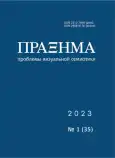The author explores the symbolism of the green colour. Biologists, chemists, botanists, florists, zoologists, artists, and other scientists have standardized, created catalogs, descriptions of colours and shades to eliminate possible errors and facilitate work. Scientists in various fields of knowledge have been interested in this topic for a very long time and comprehensively, ranging from how and in what order people recognized and named colours to assumptions about how a particular colour can affect a person or large groups of people in different circumstances and contexts. The article discusses the various meanings of colour concepts and analyses the language games associated with the visual perception of colour in the variable parameters of the living space. The history (social, cultural, symbolic) of the green colour is multi-layered and contradictory in different periods. The author made an attempt to systematize the symbolism and designate “asymmetry” in the interpretation of the green colour, to draw a conclusion about the prerequisites and consequences of this phenomenon. In Europe, at different times, it could mean luxury, prosperity, or misfortune, deceit. The green colour meant not just different meanings, but opposites: youth, love, life, and decay, poison, illness. In modern times, the green colour has a strong connection with life and prosperity. A person quite often expresses their feelings through the use of colour in one way or another. The analysis of the perception and influence of different colours on human behaviour and emotions is of great importance in psychology and related disciplines. At the moment, the basic principles of the impact of colour in marketing, advertising, positioning and brand policy are quite well studied, formulated and used. Green, like other colours, has an important place in communication and the transfer of meanings at various levels of modern culture. At the moment, there are a large number of studies and various sources of information regarding the origin, classification, history and meaning of colour, which confirms the relevance and interest in the research topic. However, blind spots, ambiguity and inconsistency in some of the findings indicate good opportunities for further work.
 9-29
9-29


 30-47
30-47


 48-77
48-77


 78-90
78-90


 91-112
91-112


 113-129
113-129


 130-139
130-139


 140-162
140-162












